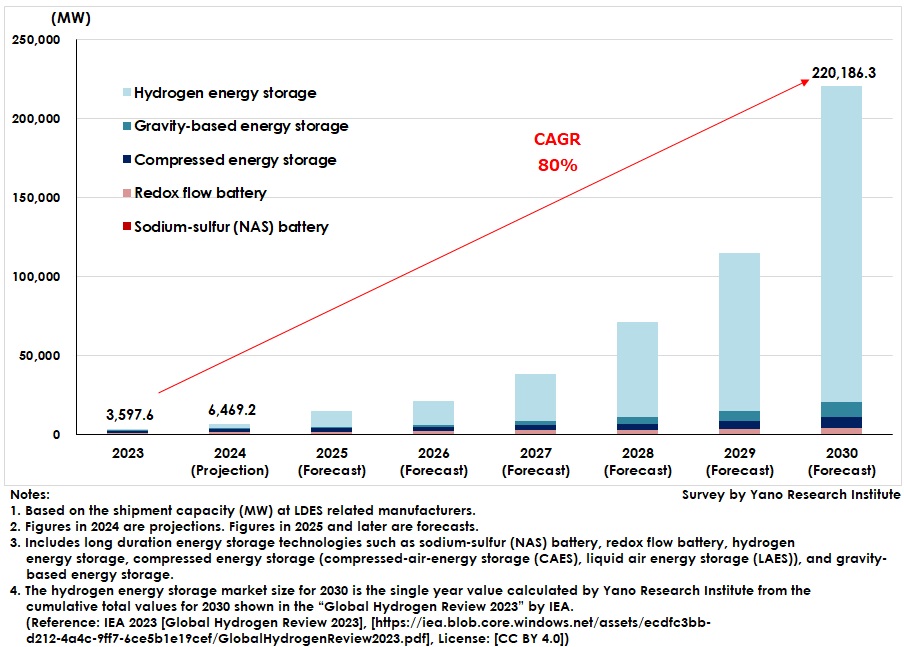No.3697
Global Market for Long Duration Energy Storage (LDES): Key Research Findings 2024
Global LDES Market Forecast to Reach 220GW by 2030
Yano Research Institute (the President, Takashi Mizukoshi) has surveyed the global market for Long Duration Energy Storage (LDES) and has found out the trends of LDES by energy type or by major country, trends of market players, and future outlook. In here discloses the global market size forecast by 2030.

Market Overview
The global market for Long Duration Energy Storage (LDES) has been estimated at 6,469.2MW in 2024, by shipment capacity, up 179.8% year over year.
To cope with extreme weather conditions caused by global warming, countries around the world are moving toward carbon neutrality and decarbonization, phasing out nuclear power plants, and expanding the use of renewable energy. Demonstrations of renewable energy and energy storage technologies are underway in major countries, which is increasing the installation of LDES, backed by reinforced government support, such as subsidies and tax benefits for commercial applications. When observing LDES by technology type, hydrogen energy storage appears to have the largest share, followed by gravity-based energy storage, compressed energy storage, redox flow batteries, and sodium-sulfur batteries.
Noteworthy Topics
The Current Mainstream is LDES with 4 to 6 Hours Duration, Predicted to Expand to 10 Hours or More in the Future
Expanded deployment of renewable energy is likely to increase the importance of longer duration of energy, for days or even across the seasons, rather than just short-term adjustment.
Long-term high-capacity energy storage technologies include 1) electrochemical technologies such as redox flow batteries and sodium-sulfur (NAS) batteries that have a charge/discharge duration of more than 10 hours, as well as hydrogen storage, 2) gravity-based energy storage technology, 3) compressed energy storage technologies that use compressed air or liquid air, and several other technologies. They are in the spotlight and are expected to be promising options for LDES.
In the current LDES market, the mainstream is considered as the storage with a charge/discharge duration of 4 to 6 hours. In the future, longer duration storage with more than 10 hours of charge/discharge is projected to be in demand, in conjunction with large renewable energy installations.
Future Outlook
To achieve carbon neutrality by 2050, the global share of renewable energy in electricity generation is expected to increase, with solar power and wind power sources being the largest contributors. This indicates that renewable energy sources will provide most of the energy supply in the future. In association with the expansion of renewable energy facilities, the importance of long-term energy storage technology is likely to increase.
Based on the above situation, the CAGR for the global LDES market from 2023 to 2030 is forecast to reach 80.0%, with the global CAGR market size attaining 220,186.3 MW in 2030.
Research Outline
2.Research Object: Manufacturers related to long duration energy storage in Japan and other countries
3.Research Methogology: Face-to-face interviews by expert researchers, and literature research
The Long Duration Energy Storage (LDES) Market
It was only recent for long duration energy storage (LDES) to begin attracting attention, and there still is no globally clear, de facto standard being established yet. In addition, there still are some differences in the definition of LDES in its ranges. In many cases in the policies and support measures in major countries, LDES is generally recognized as the storage technology that allows energy charging and discharging for more than four to ten hours.
In this research, LDES is defined as the storage technology that allows charging and discharging of energy for more than ten hours, such as sodium-sulfur (NAS) battery, redox flow battery, hydrogen energy storage, compressed energy storage (compressed-air-energy storage (CAES), liquid air energy storage (LAES)), and gravity-based energy storage. The market size has been calculated based on the shipment capacity of LDES related manufacturers.
Note that the hydrogen energy storage market size for 2030 was the single year value calculated by Yano Research Institute from the cumulative total values for 2030 shown in the “Global Hydrogen Review 2023” by IEA.
(Reference:IEA 2023 [Global Hydrogen Review 2023], [https://iea.blob.core.windows.net/assets/ecdfc3bb-d212-4a4c-9ff7-6ce5b1e19cef/GlobalHydrogenReview2023.pdf], License: [CC BY 4.0])
<Products and Services in the Market>
Energy storage systems, sodium-sulfur (NAS) battery, redox flow battery, hydrogen energy storage, compressed energy storage (compressed-air-energy storage (CAES), liquid air energy storage (LAES)), and gravity-based energy storage.
Published Report
Contact Us
The copyright and all other rights pertaining to this report belong to Yano Research Institute.
Please contact our PR team when quoting the report contents for the purpose other than media coverage.
Depending on the purpose of using our report, we may ask you to present your sentences for confirmation beforehand.